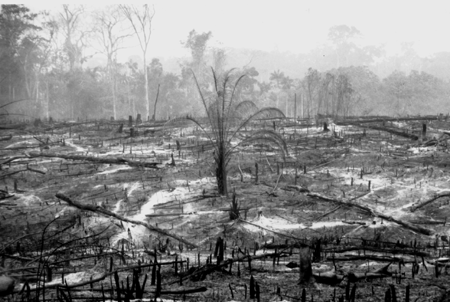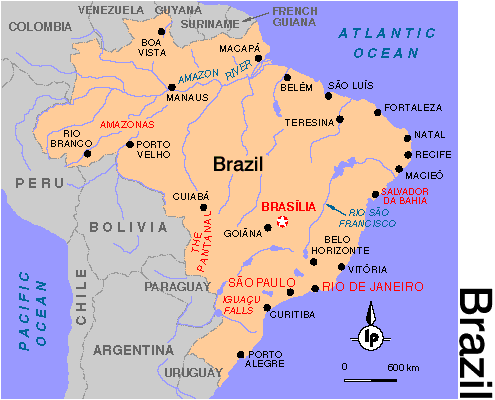| Introduction |
| Environmental Issues in LA |
| Mexico |
| Central America |
| Caribbean |
| Guiana Highlands |
| Andean Region |
| Brazil |
| Southern Cone |
| Future |
Brazil is one of the
largest countries in the world, with the most important areas of land in
the world. The Brazilian Amazon is the world’s largest and most diverse
rain forests. The Amazon accounts fully for 40% of the world’s
remaining forest cover, and contains an estimated 30% of the world’s genetic
stock (Cordiero 1998). In essence Brazil’s Amazon rain forest contains
a large portion of the world’s biodiversity. This vast forest holds
approximately 15%-20% of the world’s existing species. This great
forest is also in the path of some of the fastest development in the world.
In the Amazonian area of Brazil the migration of peasant workers has increased
at an alarming rate. This increase has also brought about many industries
that threaten the existence of this important forest. Continued logging,
charcoal production, cattle raising, peasant farming, mining have taken
a toll on the Amazon Rain Forest. Deforestation in this area threatens
not  only
the environment of the country, but also the rest of the world. In
1995 alone the Amazon suffered the loss of more than 7 million acres roughly
the size of Belgium (Laurance 1998). If this trend of deforestation
continues the existence of the Amazon Rain Forest will be in danger.
Somehow there has to be a way to slow this development, or at least find
ways to promote sustainable growth where the economy of Brazil can expand
to meet the needs of the growing population while at the same time protecting
the existence of the world’s most important natural resource. Can
some of the existing industries both promote economic growth and sustainable
use of the Amazon Rain Forest? This question becomes very difficult
and intriguing at the same time. Brazil is faced with a situation
of a booming population that needs to expand its economy to meet the growing
demands of its population. At the same time Brazil needs to protect
it’s natural resources and remaining rain forest. The economic benefits
are lost if the environment becomes a wasteland.
only
the environment of the country, but also the rest of the world. In
1995 alone the Amazon suffered the loss of more than 7 million acres roughly
the size of Belgium (Laurance 1998). If this trend of deforestation
continues the existence of the Amazon Rain Forest will be in danger.
Somehow there has to be a way to slow this development, or at least find
ways to promote sustainable growth where the economy of Brazil can expand
to meet the needs of the growing population while at the same time protecting
the existence of the world’s most important natural resource. Can
some of the existing industries both promote economic growth and sustainable
use of the Amazon Rain Forest? This question becomes very difficult
and intriguing at the same time. Brazil is faced with a situation
of a booming population that needs to expand its economy to meet the growing
demands of its population. At the same time Brazil needs to protect
it’s natural resources and remaining rain forest. The economic benefits
are lost if the environment becomes a wasteland.
Southgate did show
that sustainable development within the logging industry is possible, but
the situation must change in order for sustainable development to occur.
Emilio Moran has written on how the government could possibly take corrective
action to help the problem of deforestation in the Amazon. Moran
writes (1996, 160) that the government eliminate all tax breaks in the
rural areas. These tax breaks do nothing but encourage the wealthy
to continue practices of excessive deforestation. Expand Indian reservations
because they have proven that they take care of the forest, and this expansion
gives them constitutional rights to the land. Also cut all subsides
to cattle ranching, ranching has proven a serious detriment to the environment,
and rather give incentives for developing more land, give incentives to
make the land more efficient and more productive. This would encourage
making pastures last more than a few years, which would decrease the need
for more land clearing. Slow the construction roads in rural areas.
This is highly important in the fact that roads are a main factor in deforestation.
The roads give easy access to the forest and make it easier for timber
pirates to steal more lumber. Roads are definitely needed, but it
would serve the forest better if they were not designed to give better
access to the forest, but rather connect already urbanized areas.
The biggest policy that could change the face of deforestation in the Amazon
is the implementation of long-term land rights. Give responsible
logging companies rights to lands that might make them more efficient and
cut down on the ability to move form plot to plot. Giving rights
to these lands would give legal power to those people making it easier
to protect their land (Moran 1996, 160). These policies could make
a huge impact in slowing down deforestation all over the Amazon.
The government must take action in order to promote better environmental
thinking.

Sources
Cordierio, Marcelo; Brazil: A Pragmatic Approach, The World & I. Nov 1998.
Laurance, William; Fragments of the forest, Natural History. Jul/Aug 1998.
Moran, John; Policies of Deforestation, Columbia Press. 1996.
Sites
http://www.dpi.inpe.br/Amazonia/pg13.html
http://www.esd.ornl.gov/iab/iab3-10.htm
http://faculty.ssu.edu/~jlcavigl/adoabs.htm